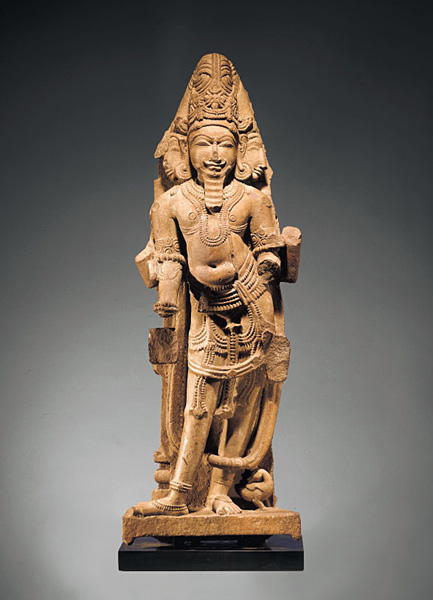|

Brahma is one of the principle gods of the Hindu pantheon, which comprises Brahma, Vishnu and Shiva. Respectively they represent the creative, preservative and destructive energies.
The three gods (trimurti) constitute the primary group of deities, the great system of Hindu gods and goddesses with all their countless ramifications.
Creation began with the universal spirit wishing to multiply itself. Out of Kama (desire) originated the primeval male god Brahma, who in turn created the world and all life. Brahma is considered to be �the master of the universe�, an immense being and the source of all that exists. He is gifted with the power to create time and space, and is the embodiment of forces from which measurable extension originates.
Depicted with four heads (three visible) and four arms, Brahma is standing in a tribhanga (thrice bend) frontal pose. Three of his four faces are visible, each of which reveals one of the four Vedas (ancient religious texts of the Indo-Aryans). His central face has a moustache and a long beard (lambakurcha). The jatamukuta is comprised of three decorated diadems and locks of hair being piled up into a high chignon. He is adorned with large circular earrings, necklaces, bracelets, anklets, strings of pearls and ornaments. The jaynopavita is the holy Brahmical cord and is depicted on his torso. The now missing attributes ascribed to brahma are related to knowledge and sacrifice. Brahma's vehicle is the swan or goose, symbol of knowledge, and is portrayed on the rectangular base at the god's left foot.
The sculpture of Brahma is carved out of fine sandstone, and shows the god as a venerable figure with hieratic features, beard and a large belly. These elements are characteristic for the mediaeval schools of sculpture during the Chandella occupation. This ethnic group had a strong cultural, political and imperial influence and ruled in central India from the 10th till the 12th century. Of the eighty-five temples constructed by the Chandella kings only twenty have survived, including the famous temples of Khajuraho, to astonish the world with their unearthly beauty and sensuality. Typical for this style are the construction of the piece, the pronounced arched eyebrows, the style of the ornaments and the shape of the jata-mukuta. By comparison to other datable sculptures this work of art in the Chandella style can be dated to the 11th century.
Brahma is represented as a powerful and convincing god and is portrayed with a vivacious facial expression. The large scale of the stone with its beautiful patina complements the monumental appearance of the deity, strengthened by an elegant tribhanga (thrice bend) movement. The striking composition consists of natural volumes, finely detailed features and deep relief carving. The sculpture is an excellent and vibrant example of the mediaeval schools of sculpture in central India. The god exhibits a restrained energy and reflects its iconographical meaning as �the master of the universe� in a superb manner.
Provenance: Private collection U.S.A.
|

